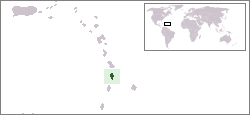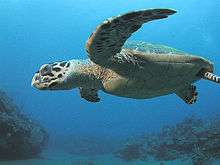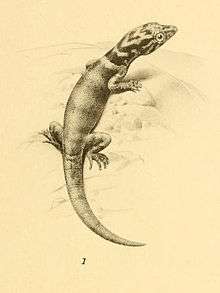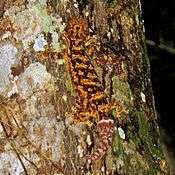List of amphibians and reptiles of Saint Lucia

Location of Saint Lucia in the Caribbean
This is a list of amphibians and reptiles found on the island-nation of Saint Lucia, located in the Caribbean Lesser Antilles.
Amphibians
There are three species of amphibian on Saint Lucia, two of which were introduced.
Frogs (Anura)
| Tree frogs (Hylidae) | |||
|---|---|---|---|
| Species | Common name(s) | Notes | Image |
| Scinax ruber | Red-snouted tree frog | Least Concern.[1] | |
| Tropical frogs (Leptodactylidae) | |||
| Species | Common name(s) | Notes | Image |
| Eleutherodactylus johnstonei | Lesser Antillean whistling frog, coqui Antillano, Johnstone's whistling frog | Least Concern. |  |
| True toads (Bufonidae) | |||
| Species | Common name(s) | Notes | Image |
| Bufo marinus | Cane toad, giant neotropical toad, marine toad | Least Concern. Introduced. | |
Reptiles
Including marine turtles and introduced species, there are 20 reptile species reported on Saint Lucia, five of which are endemic.
Turtles (Testudines)
| Tortoises (Testudinidae) | |||
|---|---|---|---|
| Species | Common name(s) | Notes | Image |
| Geochelone carbonaria | Red-footed tortoise | Likely recent introduction, though possibly as long ago as Amerindian settlement of Saint Lucia.[2] Rarely seen in the wild. |  |
| Scaly sea turtles (Cheloniidae) | |||
| Species | Common name(s) | Notes | Image |
| Caretta caretta | Loggerhead turtle, channel turtle (local name) | Endangered. |  |
| Chelonia mydas | Green turtle | Endangered. Regularly seen in coastal waters; nests on both coasts (though mainly on northern beaches), primarily from June to October. |  |
| Eretmochelys imbricata | Hawksbill turtle | Critically Endangered. Regularly seen in coastal waters; nests on both coasts (though mainly on northern beaches), primarily from May to October. |  |
| Leathery sea turtles (Dermochelyidae) | |||
| Species | Common name(s) | Notes | Image |
| Dermochelys coriacea | Leatherback turtle | Critically Endangered. Fairly rare. Nesting recorded from April to June, primarily on south and east (Atlantic) coast beaches. |  |
Lizards and snakes (Squamata)
| Geckos (Gekkonidae) | |||
|---|---|---|---|
| Species | Common name(s) | Notes | Image |
| Hemidactylus mabouia | House gecko | Introduced. | .jpg) |
| Hemidactylus palaichthus | Antilles leaf-toed gecko | Restricted to offshore islands of Maria Major and Dennery Island. | |
| Sphaerodactylus microlepis | Little-scaled least gecko |  | |
| Sphaerodactylus vincenti | Vincent's least gecko | Regional endemic. |  |
| Thecadactylus rapicauda | Turnip-tailed gecko |  | |
| Iguanas and Anolids (Iguanidae) | |||
| Species | Common name(s) | Notes | Image |
| Anolis extremus | Barbados anole | Regional endemic. Introduced from Barbados. Restricted to the area around the capital, Castries. |  |
| Anolis luciae | St. Lucia anole, Saint Lucian anole | Endemic. Widespread. | |
| Anolis wattsi | Watts' anole | Regional endemic. Introduced. Restricted to the area around the capital, Castries. | |
| Iguana iguana | Green iguana, common iguana |  | |
| Whiptails (Teiidae) | |||
| Species | Common name(s) | Notes | Image |
| Cnemidophorus vanzoi | St Lucia whiptail, Vanzo's whiptail | Vulnerable. Endemic. The only Cnemidophorus species found in the Caribbean. Extirpated from the main island and now only native to the small islets of Maria Major and Maria Minor, with fewer than 1000 individuals estimated. A third population has been established on nearby Praslin Island through translocation.[3] | |
| Microteiids (Gymnophthalmidae) | |||
| Species | Common name(s) | Notes | Image |
| Gymnophthalmus pleei | Martinique spectacled tegu | Regional endemic. | |
| Skinks (Scincidae) | |||
| Species | Common name(s) | Notes | Image |
| Mabuya mabouya[4] | Regional endemic. Possibly extirpated. |  | |
| Worm snakes (Typhlopidae) | |||
| Species | Common name(s) | Notes | Image |
| Leptotyphlops breuili[5] | St. Lucia threadsnake | Endemic. First described as a separate species in 2008. |  |
| Boas (Boidae) | |||
| Species | Common name(s) | Notes | Image |
| Boa constrictor | Boa constrictor | ||
| Colubrids (Colubridae) | |||
| Species | Common name(s) | Notes | Image |
| Liophis ornatus | St Lucia racer | Endangered. Endemic. Probably extirpated from the main island; present on Maria Major but rare. | |
| Vipers (Viperidae) | |||
| Species | Common name(s) | Notes | Image |
| Bothrops caribbaeus | Saint Lucia lancehead | Endemic. Distributed in lowlands, commonly found along river valleys. | |
Notes
- ↑ Conservation status, where available, is from the IUCN Red List and is indicative of the status of the species as a whole, not just populations on Saint Lucia.
- ↑ Malhotra 2007, p. 182. The authors previously doubted there was a viable natural population, attributing its presence to escaped pets. Malhotra 1999, p. 49.
- ↑ Powell & Henderson 2005, p. 66.
- ↑ Malhotra & Thorpe 1999 instead records M. bistriata as the sole Mabuya species in the Lesser Antilles; many of its Caribbean populations have since been reassigned.
- ↑ Hedges 2008. Recorded in Malhotra & Thorpe 1999 as Leptotyphlops bilineata.
References
Note: All species listed above are supported by Malhotra & Thorpe 1999, unless otherwise cited.
- Hedges, S. Blair (2008), "At the lower size limit in snakes: two new species of threadsnakes (Squamata: Leptotyphlopidae: Leptotyphlops) from the Lesser Antilles" (PDF), Zootaxa 1841: 1–30, retrieved March 5, 2010
- Malhotra, Anita; Thorpe, Roger S. (1999), Reptiles & Amphibians of the Eastern Caribbean, Macmillan Education Ltd., pp. 92–97, ISBN 0-333-69141-5.
- Powell, Robert; Henderson, Robert W. (2005), "Conservation Status of Lesser Antillean Reptiles", Iguana 12 (2): 63–77
| ||||||||||
This article is issued from Wikipedia - version of the Wednesday, April 29, 2015. The text is available under the Creative Commons Attribution/Share Alike but additional terms may apply for the media files.